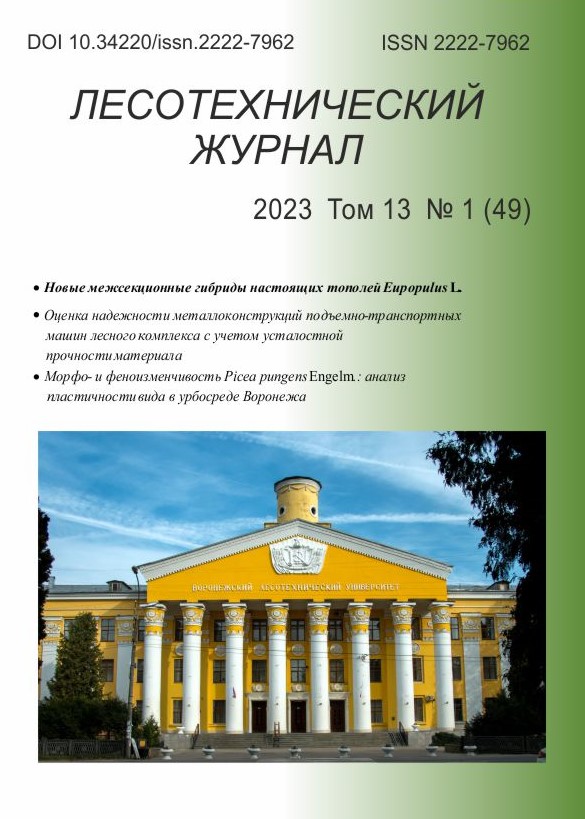Voronezh, Russian Federation
Russian Federation
Voronezh, Russian Federation
Voronezh, Russian Federation
Minsk, Russian Federation
UDC 630
CSCSTI 68.47
In the Central Chernozem region of the Russian Federation, since 2010, the gap between the phenological development of plants and abiotic environmental factors has been increasing. In order to increase the biodiversity of the flora of megacities, the question of selecting an assortment of plant species that are resistant to a complex of natural and anthropogenic changes at the same time remains relevant. One of these species is the prickly spruce (Picea pungens Engelm.). The diameter of the trunk at chest height, the height of the tree, the number of macrostrobes, the length and color of the needles of specimens (N = 50) growing in urban plantations of Voronezh were studied. The length of the needles of the studied trees is identical to the length of the needles of trees in the natural range. In 20-30-year-old trees, blue-coniferous forms predominate, there is a fairly strong positive correlation between the diameter of the trunk and the height of the tree (r = 0.65).The beginning of growth and the end of shoots were recorded, the timing of the laying of wintering buds in prickly spruce trees (Picea pungens Engelm.). The vegetation period of the studied species is comparable with the phenorhythmics of the local (aboriginal) species of European spruce (Picea abies (L.) Karst.). The data indicate a sufficiently high adaptability of the prickly spruce (Picea pungens Engelm.) to the expansion of its potential range. We believe that this species is promising for widespread use in various recreational areas of megacities. In the future, it is necessary to answer the question: how will the phenorhythmics of the studied species affect vegetative reproduction to form the basis of the local phenotype?
blue spruce (Picea pungens Engelm.), introduced, morphology, phenology, urban forest
1. Martin Hadad, Jacques C.Tardif, France Conciatori, JustinWaito, Alana Westwood. Climate and atmospheric circulation related to frost-ring formation in Picea mariana trees from the Boreal Plains, interior North America. Weather and Climate Extreme. 2020;29: 100264. DOI: // https://doi.org/10.1016/j.wace.2020.100264.
2. Lidia A. Semkina. Growth and Productivity of Non-Indigenous Woody Species in the Middle Urals. Lesnoy Zhurnal (Forestry Journal). 2021; 6: 100-109. DOI: // https://dx.doi.org//https://doi.org/10.37482/0536-1036-2021-6-100-109. EDN: https://elibrary.ru/QSVKAT
3. KlimatVoronezha - Pogodaiklimat. URL: http:/http://www.pogodaiklimat.ru
4. Alexey V. Kabonen, Natalya V. Ivanova. Tree attribute assessment in urban greenwood using ground-based LiDAR and multiseasonal aerial photography data. Nature Conservation Research. 2023; 8(1): 64-83. DOI: // https://dx.doi.org/10.24189/ncr.2023.005. EDN: https://elibrary.ru/ODZRWG
5. Xi Cao,Fang Gao,Caiyun Qin,Shigang Chen,Jufeng Cai, Changbin Sun,Yuhui Weng, Jing Tao. Optimizing Somatic Embryogenesis Initiation, Maturation and Preculturing for Cryopreservation in Picea pungens. Forests. 2022; 13(12): 2097.DOI:// https://dx.doi.org /10.3390/f13122097. EDN: https://elibrary.ru/EHSFSJ
6. Zdeněk Vacek, Jan Cukor,Stanislav Vacek, Rostislav Linda,Anna Prokůpková,Vilém Podrázský, Josef Gallo, Oldřich Vacek, Václav Šimůnek , Ondřej Drábek , Vojtěch Hájek , Marko Spasić , Jakub Brichta. Production potential, biodiversity and soil properties of forest reclamations: Opportunities or risk of introduced coniferous tree species under climate change?/ European Journal of Forest Research. 2021; 140(5): 1243-1266. DOI: // https://dx.doi.org//10.1007/s10342-021-01392-x. EDN: https://elibrary.ru/QFSHKC
7. Francesco Ferrini , Alessio Fini , Jacopo Mori , Antonella Gori. Role of vegetation as a mitigating factor in the urban context. Sustainability. 2021; 12(10): 4247. DOI: // https://dx.doi.org//10.3390/su12104247.
8. Idalia Kasprzyk, Tomasz Wójcik, Paloma Cariñanos, Katarzyna Borycka, Agata Ćwik. Evaluation of the allergenicity of various types of urban parks in a warm temperate climate zone. Aerobiologia. 2018; 35(1): 57-71. DOI: // https://dx.doi.org//10.1007/s10453-018-9537-3.
9. Anna Kulkova, Natalia Besschetnova, Vladimir Besschetnova. Multiparameter Evaluation of the Taxonomic Proximity of the Species of Spruce (Picea A. Dietr.) in the Pigment Composition of Needles. Vestnik of Volga State University of Technology. Ser.: Forest. Ecology. Nature Management. 2018; 1(37): 5-18. DOI: // https://dx.doi.org//10.15350/2306-2827.2018.1.5.
10. T.V. Zubkova, O.A. Dubrovina. The study of ecological and biological condition of colorado spruce (Piceapungens Engelm.) in the urban environment of yelets cit. Pomiculture and small fruits culture in Russia. 2019; 57(1): 61-66. DOI: // https://dx.doi.org//https://doi.org/10.31676/2073-4948-2019-57-61-66. EDN: https://elibrary.ru/YODONR
11. Sergei V.Skupnevskii , Valerii N.Rakitskii , Tatina A.Synitskaya , Igor A.Nikolaev , Victoriya V. Tsagaeva. Efficiency of usage evergreen plants as test objects of hygiene monitoring in an industrial city. Hygiene and sanitation. 2020; 99 (7): 669-673. DOI: // https://dx.doi.org//10.47470/0016-9900-2020-99-7-669-673. DOI: https://doi.org/10.33029/0016-9900-2020-99-7-669-673; EDN: https://elibrary.ru/EHPDVZ
12. Dimitar Petrov Dimitrov, Miglena Zhiyanski. Dendrochronological analysis of the influence of climate on autochthonous and introduced coniferous tree species in the city park "Prostor", Kardzhali. Silva Balcanica. 2022; 23(1): 11-19. DOI: //https://dx.doi.org /https://doi.org/10.3897/silvabalcanica.23.e79249. EDN: https://elibrary.ru/RLLIYV
13. Junchen Wang , Jianwei Ma, Fangqun Ouyang , Junhui Wang, Lu Song, Lisheng Kong, Hanguo Zhang. Instrinsic relationship among needle morphology, anatomy, gas exchanges and tree growth across 17 Picea species. New Forests. 2020; 52(3): 509-535. DOI: //https://dx.doi.org//https://doi.org/10.1007/s11056-020-09808-z.
14. Vaclav Sticha, Ram P. Sharma, Zdenek Vacek,Stanislav Vacek, Ondrej Nuhlicek. Timber and Branch Volume Prediction: Effects of Stand and Site Characteristics on Dendromass and Timber-To-Branch Volume Ratio of Norway Spruce in Managed Forests. Forests. 2019; 10(2): 144. DOI: // https://doi.org/10.3390/f10020144. EDN: https://elibrary.ru/WWJJFL
15. Zdenek Vacek, Stanislav Vacek, Anna Prokupkova, Daniel Bulusek, Vilem Podrazsky, Iva Hunova, Tereza Putalova, Jan Kral. Long-term effect of climate and air pollution on health status and growth of Picea abies (L.) Karst. peaty forests in the Black Triangle region. Dendrobiology. 2020; 83: 1-19. DOI: // http://dx.doi.org/10.12657/denbio.083.001.
16. O.S. Zalivskaya, N.A. Babich. Assessment of decorative plantings. Lesnoy Zhurnal (Forestry Journal). 2020; 6: 98-110. DOI: // https://dx.doi.org//10.37482/0536-1036-2020-6-98-110. EDN: https://elibrary.ru/LTJUYR
17. M.J.Vergotti, M.Fernandez-Martinez, S.C.Kefauver, I.A.Janssens, J.Penuelas.Weather and trade-offs between growth and reproduction regulate fruit production in European forests. Agricultural and Forest Meteorology. 2019; 279: 107711. DOI:// https://doi.org/10.1016/j.agrformet.2019.107711.
18. Lyudmila Lyashcheva, Aleksandr Lyashchev, Irina Prok. Influence of biologically active substances, chemicals and growth regulators on diseases of conifers in urban conditions. BIO Web of Conferences. 2020: 43: 2024-2024. DOI:https://dx.doi.org/10.1051/bioconf/20224302024.
19. L.C. Fonseca, T.A. Magalhaes, L.A. Melo, L.S. Oliveira, G.E. Brondani. Rescue and vegetative propagation of Eremanthus erythropappus (DC.). MacLeish in natural stand. Brazilian Journal of Biology.2021; 81 (3). DOI: https://doi.org/10.1590/1519-6984.225119.
20. Hänninen H., Kramer K., Tanino K., Zhang R., Wu J and Fu Y. Experiments are necessary in process-based tree phenology modelling. TrendsPlant. 2019; Volume24(3): 199-209. DOI: https://doi.org/10.1016/j.tplants.2018.11.006. EDN: https://elibrary.ru/QVSGKG
21. Malyukov S. V., Ekspluataciya pochvoobrabatyvayuschih orudiy v usloviyah neraskorchevannyh vyrubok evropeyskoy chasti Rossii: analiz prepyatstviy v vide pney i korney / S. V. Malyukov, E. V. Pozdnyakov, S. I. Degtyareva, M. V. Shavkov, M. A. Malyukova, I. I. Shanin, S. E. Ariko // Lesotehnicheskiy zhurnal. - 2022. - T. 12. - № 4 (48). - S. 96-113. - DOI: https://doi.org/10.34220/issn.2222- 7962/2022.4/7. DOI: https://doi.org/10.34220/issn.2222-7962/2022.4/7; EDN: https://elibrary.ru/MDPNGH












